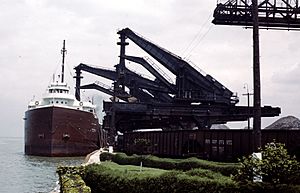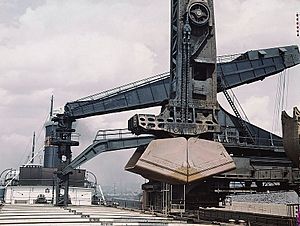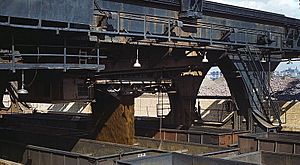Hulett facts for kids

The Hulett was a huge machine designed to unload iron ore from ships. It was used a lot on the Great Lakes in North America. These giant unloaders helped move a lot of ore, which is a key ingredient for making steel.
Contents
History of the Hulett
The Hulett machine was invented by George Hulett. He was from Conneaut, Ohio. He got a patent for his invention in 1898. The very first working Hulett was built the next year, in 1899, at Conneaut Harbor.
At first, these machines ran on steam power. They worked very well! Many more Huletts were built along the Great Lakes. Most of them were on the southern shore of Lake Erie. Their job was to unload boats filled with taconite, which is a type of iron ore. This ore came from mines near Lake Superior. Later, in the 1920s, John W. Ahlberg changed the Huletts in Conneaut to run on electricity. Other improvements were made by Samuel T. Wellman.
How Huletts Changed Shipping
The Hulett machine completely changed how iron ore was shipped on the Great Lakes. Before Huletts, unloading ships was slow and cost a lot. Workers had to use hoists and buckets, and it took many people. It cost about 18 cents for every ton of ore. But with Huletts, the cost dropped to only 6 cents per ton (in 1901 money).
Unloading a ship used to take days. With a Hulett, it only took 5 to 10 hours! Because of this, the design of lake boats also changed. They became much bigger, doubling in length and holding four times more ore.
By 1913, there were 54 Hulett machines working. Most of them were along Lake Erie. A few were used at Lake Superior to unload coal. Five were built in Gary, Indiana. Overall, about 75 Huletts were built. They helped ore shipping more than double between 1900 and 1912. One Hulett was even used in New York City to unload garbage!
The End of the Huletts
The Huletts on the Great Lakes were used until about 1992. By then, most ships on the American side of the lake were "self-unloading boats." These new ships could unload themselves, so the Huletts were no longer needed. All of them have since been taken apart.
By 1999, only six Huletts were left. Four of them were in Cleveland, at Whiskey Island. These were the oldest ones. Another set was used in South Chicago to unload coal barges until 2002. They were taken down in 2010.
The Cleveland Huletts were very important. They were on the National Register of Historic Places. They were also named a Historic Mechanical Engineering Landmark. But in 2000, the Cleveland Port Authority took them down. This was to make space for new buildings. The Port Authority saved two of the Huletts, hoping to rebuild them somewhere else. But that has not happened yet.
How a Hulett Works
The Hulett unloader was powered by electricity. It moved along two parallel tracks on the docks. One track was near the water, and the other was further back. There were usually four railroad tracks in between them. Strong steel towers, which had wheels, held up large beams that stretched over the railroad tracks.
A special carriage moved along these beams. This carriage could move closer to or further away from the ship. On the carriage was a big arm called a walking beam. This arm could be raised or lowered. At the end of this arm, facing the ship, was a tall column with a huge scoop bucket. Another arm was attached halfway down the column to keep it straight as it moved.
The person operating the Hulett sat in a cab on the vertical column, right above the bucket. This gave them the best view of the ship's cargo. They could also spin the column and bucket in any direction. The giant scoop bucket would be lowered into the ship's hold. Then, it would close to grab about 10 tons of ore. After that, it would lift the ore and move it back towards the dock. The workers who operated these huge machines were known as Ore Hogs.
To make things faster, a moving hopper was used. This hopper ran between the main beams. The Hulett's bucket would dump its load into this hopper. Then, the hopper would move back to drop the ore into a waiting railroad car. Sometimes, it would dump the ore onto a large pile at the back of the dock.
The Hulett could also move along the dock. This allowed it to line up with different sections of the ore boat. When a ship's hold was almost empty, the Hulett couldn't get all the ore. So, workmen would go into the hold. They would shovel the last bits of ore into the Hulett's bucket. Later, a small wheeled excavator was sometimes chained to the Hulett's bucket. It would be lowered into the hold to help fill the bucket.






